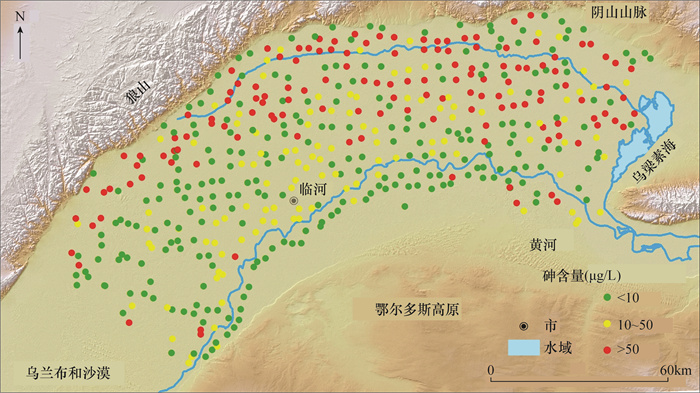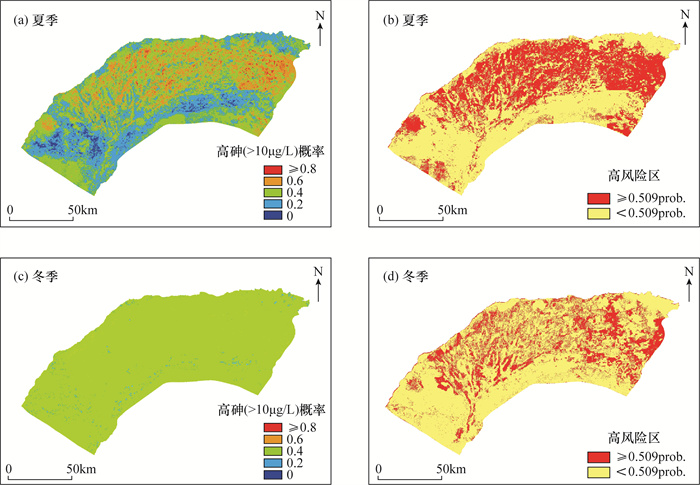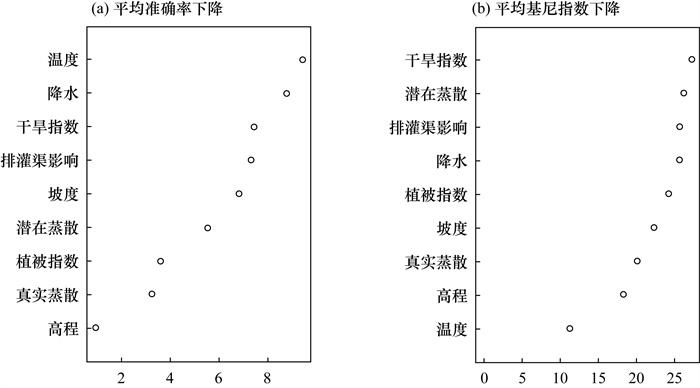High Arsenic Risk Distribution Prediction of Groundwater in the Hetao Basin by Random Forest Modeling
-
摘要:
河套盆地浅层地下水砷污染严重,对当地居民健康造成严重影响。当前对河套盆地浅层地下水高砷分布的研究受限于采样时间和样本数量,难以从宏观角度对河套盆地高砷地下水的空间分布作出较为全面的评价。本文基于研究区506个浅层地下水样品,以9个地表环境参数为初始预测变量,经过最佳变量组合筛选,采用随机森林建模来产生风险概率,评价了预测变量的重要性以及对高砷地下水的影响。以气候因子为动态预测变量,根据模型识别不同季节地下水高砷的概率分布并制作了风险区专题图。结果表明:研究区的地下水样品砷含量为0.05~916.7μg/L,超标率(砷浓度>10μg/L)为50%;地下水高砷风险区主要分布在河套盆地的沉积中心地带,但冬季高砷风险区面积减少1907km2,占研究区总面积14.14%;降水、干旱指数、排灌渠影响、潜在蒸散、温度是影响高砷地下水最重要的指标。研究认为,河套盆地的气候变量(降水、干旱指数)与含水层砷含量显著相关,控制高砷地下水在河套盆地的沉积中心地带发生季节性变化。
Abstract:BACKGROUND Arsenic pollution is a serious problem in shallow groundwater in the Hetao Basin, and has seriously affected the health of residents. The research on the distribution of high arsenic shallow groundwater in the Hetao Basin is limited by the sampling time and sample number.
OBJECTIVES To obtain a comprehensive understanding of the risk distribution characteristics and important influencing factors of high arsenic groundwater in different seasons in the region.
METHODS Based on 506 shallow groundwater samples and 9 surface environmental parameters as prediction variables, a random forest model was established to evaluate the importance of prediction variables and the impact of important variables on high arsenic groundwater. Taking the climate factors as the dynamic prediction variables, the probability distribution of high arsenic groundwater in different seasons was identified and thematic maps of risk areas were made.
RESULTS The results showed that the arsenic content of 506 groundwater samples ranged from 0.05 to 916.7μg/L with an overshoot rate (>10μg/L) of 50%. Groundwater arsenic risk areas were mainly distributed in the depositional center of the Hetao Basin, but the area of groundwater arsenic risk areas decreased by 1907km2 in winter, accounting for 14.14% of the total area. Precipitation and drought index, influence of drainage and irrigation channels, potential evapotranspiration and temperature were the most important indexes affecting the high arsenic groundwater in this area.
CONCLUSIONS In the Hetao Basin, climate variables (precipitation and drought index) are significantly correlated with arsenic accumulation in the aquifer, which controls the seasonal variation of groundwater with high arsenic content in the depositional center of the Hetao Basin.
-
Key words:
- groundwater /
- arsenic pollution /
- Hetao Basin /
- random forest /
- seasonal variation /
- risk distribution
-

-
表 1 模型预测变量及描述
Table 1. Predictor variables and descriptions of the model
类别 变量 描述 气候 真实蒸散 平均真实蒸散量(mm/mr) 干旱指数 温度植被干旱指数 潜在蒸散 平均潜在蒸散量(mm/mr) 降水 平均降雨量(mm/mr) 温度 平均温度(℃/mr) 地形 高程 单位为m 坡度 单位为(°) 其他 排灌渠影响 排干、灌渠影响 植被指数 归一化植被指数 表 2 随机森林模型的混淆矩阵(概率截断值=0.5)
Table 2. Confusion matrix of the random forest model (probability cutoff=0.5)
预测类别 真实类别 0 1 0 31 12 1 14 44 表 3 随机森林模型的统计数据(概率截断值=0.5)
Table 3. Statistics data of the random forest model (probability cutoff=0.5)
评估参数 参数数值 评估参数 参数数值 准确率 0.7426 特异性 0.7857 无信息率 0.5545 阳性预测值 0.7209 p 7.338×10-5 阴性预测值 0.7586 Kappa系数 0.4767 流行度 0.4455 敏感性 0.6889 平衡精度 0.7373 -
[1] Polya D A, Middleton D R. Arsenic in drinking water: Sources & human exposure[M]//Bhattacharya P, Polya D A, Draganovic D. Best practice guide on the control of arsenic in drinking water (The 1st edition). London: International Water Association Publishing, 2017.
[2] Tong J, Guo H, Wei C. Arsenic contamination of the soil-wheat system irrigated with high arsenic groundwater in the Hetao Basin, Inner Mongolia, China[J]. Science of the Total Environment, 2014, 496: 479-487. doi: 10.1016/j.scitotenv.2014.07.073
[3] 杨文蕾, 沈亚婷. 水稻对砷吸收的机理及控制砷吸收的农艺途径研究进展[J]. 岩矿测试, 2020, 39(4): 475-492. http://www.ykcs.ac.cn/article/doi/10.15898/j.cnki.11-2131/td.202004160052
Yang W L, Shen Y T. A review of research progress on the absorption mechanism of arsenic and agronomic pathways to control arsenic absorption[J]. Rock and Mineral Analysis, 2020, 39(4): 475-492. http://www.ykcs.ac.cn/article/doi/10.15898/j.cnki.11-2131/td.202004160052
[4] Wang Y, Pi K, Fendorf S, et al. Sedimentogenesis and hydrobiogeochemistry of high arsenic Late Pleistocene-Holocene aquifer systems[J]. Earth-Science Reviews, 2019, 189: 79-98. doi: 10.1016/j.earscirev.2017.10.007
[5] Podgorski J, Berg M. Global threat of arsenic in ground-water[J]. Science, 2020, 368: 845-850. doi: 10.1126/science.aba1510
[6] Jia Y, Guo H, Jiang Y, et al. Hydrogeochemical zonation and its implication for arsenic mobilization in deep groundwaters near alluvial fans in the Hetao Basin, Inner Mongolia[J]. Journal of Hydrology, 2014, 518(Part C): 410-420. http://www.sciencedirect.com/science/article/pii/S0022169414001012
[7] 曹文庚, 董秋瑶, 谭俊, 等. 河套盆地晚更新世以来黄河改道对高砷地下水分布的控制机制[J]. 南水北调与水利科技, 2021, 19(1): 140-150. https://www.cnki.com.cn/Article/CJFDTOTAL-NSBD202101014.htm
Cao W G, Dong Q Y, Tan J, et al. The mechanism of Yellow River diversion in controlling high arsenic groundwater distribution since the Late Pleistocene[J]. South-to-North Water Transfers and Water Science & Technology, 2021, 19(1): 140-150. https://www.cnki.com.cn/Article/CJFDTOTAL-NSBD202101014.htm
[8] 高存荣, 刘文波, 冯翠娥, 等. 干旱半干旱地区高砷地下水形成机理研究: 以中国内蒙古河套平原为例[J]. 地学前缘, 2014, 21(4): 13-29. https://www.cnki.com.cn/Article/CJFDTOTAL-DXQY201404003.htm
Gao C R, Liu W B, Feng C E, et al. Study on the formation mechanism of high arsenic groundwater in arid and semi-arid areas: Taking Hetao Plain in Inner Mongolia as an example[J]. Earth Science Frontier, 2014, 21(4): 13-29. https://www.cnki.com.cn/Article/CJFDTOTAL-DXQY201404003.htm
[9] Cao W G, Guo H M, Zhang Y L, et al. Controls of paleochannels on groundwater arsenic distribution in shallow aquifers of alluvial plain in the Hetao Basin, China[J]. Science of the Total Environment, 2018, 613-614: 958-968. doi: 10.1016/j.scitotenv.2017.09.182
[10] Guo H M, Li X M, Xiu W, et al. Controls of organic matter bioreactivity on arsenic mobility in shallow aquifers of the Hetao Basin, P.R. China[J]. Journal of Hydrology, 2019, 571: 448-459. doi: 10.1016/j.jhydrol.2019.01.076
[11] 李媛. 内蒙古河套盆地高砷含水系统的微生物特征及生物地球化学效应[D]. 北京: 中国地质大学(北京), 2016.
Li Y. Microbial characteristics and biogeochemical effects of high arsenic aquifer system in Hetao Basin, Inner Mongolia[D]. Beijing: China University of Geosciences (Beijing), 2016.
[12] Shen M M, Guo H M, Jia Y F, et al. Partitioning and reactivity of iron oxide minerals in aquifer sediments hosting high arsenic groundwater from the Hetao Basin, P.R. China[J]. Applied Geochemtry, 2018, 89: 190-201. doi: 10.1016/j.apgeochem.2017.12.008
[13] Dietrich S, Bea S A, Weinzettel P, et al. Occurrence and distribution of arsenic in the sediments of a carbonate-rich unsaturated zone[J]. Environmental Earth Sciences, 2016, 75(2): 1-14. http://www.ihlla.org.ar/sites/default/files/integrantes/CVs/cv_sabea_0.pdf
[14] 高存荣. 河套平原地下水砷污染机理的探讨[J]. 中国地质灾害与防治学报, 1999(2): 25-32. https://www.cnki.com.cn/Article/CJFDTOTAL-ZGDH902.003.htm
Gao C R. Research on the mechanism of arsenic pollution in groundwater in the Hetao Plain, Inner Mongolia, China[J]. The Chinese Journal of Geological Hazard and Control, 1999(2): 25-32. https://www.cnki.com.cn/Article/CJFDTOTAL-ZGDH902.003.htm
[15] Guo H M, Li Y, Zhao K, et al. Removal of arsenite from water by synthetic siderite: Behaviors and mechanisms[J]. Journal of Hazardous Materials, 2011, 186(2-3): 1847-1854. doi: 10.1016/j.jhazmat.2010.12.078
[16] Zhang Z, Guo H, Zhao W, et al. Influences of groundwater extraction on flow dynamics and arsenic levels in the western Hetao Basin, Inner Mongolia, China[J]. Hydrogeology Journal, 2018, 26(5): 1499-1512. doi: 10.1007/s10040-018-1763-9
[17] Ayotte J D, Nolan B T, Nucklos J R, et al. Modeling the probability of arsenic in groundwater in New England as a tool for exposure assessment[J]. Environmental Science & Technology, 2006, 40: 3578-3585. http://webarchive.library.unt.edu/eot2008/20081108061849/http:/vt.water.usgs.gov/Publications/2006/es051972f.pdf
[18] Rodríguez-Lado L, Sun G, Berg M, et al. Groundwater arsenic contamination throughout China[J]. Science, 2013, 341: 866-868. doi: 10.1126/science.1237484
[19] Wu R H, Joel P, Michael B, et al. Geostatistical model of the spatial distribution of arsenic in groundwater in Gujarat State, India[J]. Environmental Geochemistry and Health, 2021, 43: 2649-2664. doi: 10.1007/s10653-020-00655-7
[20] Bretzler A, Lalanne F, Nikiema J, et al. Groundwater arsenic contamination in Burkina Faso, West Africa: Predicting and verifying regions at risk[J]. Science of the Total Environment, 2017, 584-585: 958-970. doi: 10.1016/j.scitotenv.2017.01.147
[21] 苏彩红, 向娜, 陈广义, 等. 基于人工蜂群算法BP神经网络的水质评价模型[J]. 环境工程学报, 2012, 6(2): 699-704. https://www.cnki.com.cn/Article/CJFDTOTAL-HJJZ201202065.htm
Su C H, Xiang N, Chen G Y, et al. Water quality evaluation model based on artificial bee colony algorithm and BP neural network[J]. Journal of Environmental Engineering, 2012, 6(2): 699-704. https://www.cnki.com.cn/Article/CJFDTOTAL-HJJZ201202065.htm
[22] He Z B, Wen X H, Liu H, et al. A comparative study of artificial neural networks, adaptive neuro fuzzy inference system and support vector machine for forecasting river flow in the semi-arid mountain region[J]. Journal of Hydrology, 2014, 509: 379-386. doi: 10.1016/j.jhydrol.2013.11.054
[23] Podgorski J E, Labhasetwar P, Saha D, et al. Prediction modeling and mapping of groundwater fluoride contamination throughout India[J]. Environmental Science and Technology, 2018, 52(17): 9889-9898. doi: 10.1021/acs.est.8b01679
[24] Iverson L R, Prasad A M, Matthews S N, et al. Estimating potential habitat for 134 eastern US tree species under six climate scenarios[J]. Forest Ecology and Management, 2008, 254: 390-406. doi: 10.1016/j.foreco.2007.07.023
[25] 邓娅敏. 河套盆地西部高砷地下水系统中的地球化学过程研究[D]. 武汉: 中国地质大学(武汉), 2008.
Deng Y M. Study on geochemical process in high arsenic groundwater system in western Hetao Basin[D]. Wuhan: China University of Geosciences (Wuhan), 2008.
[26] 袁溶潇. 内蒙古河套盆地含水层沉积物可溶性组分与可溶性砷的分布规律研究[D]. 北京: 中国地质大学(北京), 2017.
Yuan R X. Soluble components of sediments and their relation with soluble arsenic in aquifers from the Hetao Basin, Inner Mongolia[D]. Beijing: China University of Geosciences (Beijing), 2017.
[27] 刘文波. 河套平原地下水化学特征研究[D]. 北京: 中国地质大学(北京), 2015.
Liu W B. Chemical characteristics of groundwater in Hetao Plain[D]. Beijing: China University of Geosciences (Beijing), 2015.
[28] 何薪. 河套平原农业灌溉影响下地下水中砷迁移富集规律研究[D]. 武汉: 中国地质大学(武汉), 2010.
He X. Study on the migration and enrichment law of arsenic in groundwater under the influence of agricultural irrigation in Hetao Plain[D]. Wuhan: China University of Geosciences (Wuhan), 2010.
[29] Breiman L. Random forests[J]. Machine Learning, 2001, 45(1): 5-32. doi: 10.1023/A:1010933404324
[30] Fawcett T. An introduction to ROC analysis[J]. Pattern Recognition Letters, 2006, 27(8): 861-874. doi: 10.1016/j.patrec.2005.10.010
[31] Bindal S, Singh C K. Predicting groundwater arsenic contamination: Regions at risk in highest populated state of India[J]. Water Research, 2019, 159: 65-76. doi: 10.1016/j.watres.2019.04.054
[32] Podgorski J E, Eqani S A M A S, Khanam T, et al. Extensive arsenic contamination in high-pH unconfined aquifers in the Indus Valley[J]. Science Advances, 2017, 3: 1-10. http://d3a5ak6v9sb99l.cloudfront.net/content/advances/3/8/e1700935.full.pdf
[33] Erickson M L, Elliott S M, Christenson, et al. Predicting geogenic arsenic in drinking water wells in glacial aquifers, North-Central USA: Accounting for depth-dependent features[J]. Water Resources Research, 2018, 54(12): 172-187, 10. http://www.onacademic.com/detail/journal_1000041601093199_2916.html
[34] Zhang Q, Rodríguez-Lado L, Johnson C A, et al. Predicting the risk of arsenic contaminated groundwater in Shanxi Province, northern China[J]. Environmental Pollution, 2012, 165: 118-123. doi: 10.1016/j.envpol.2012.02.020
[35] Michael V S, Samantha C Y, Shawn G B, et al. Aquifer arsenic cycling induced by seasonal hydrologic changes within the Yangtze River Basin[J]. Environmental Science & Technology, 2016, 50(7): 3521-3529.
[36] Yadav I C, Devi N L, Singh S. Spatial and temporal variation in arsenic in the groundwater of upstream of Ganges River Basin, Nepal[J]. Environmental Earth Science, 2015, 73: 1265-1279. doi: 10.1007/s12665-014-3480-6
[37] Alarcón-Herrera M T, Bundschuh J, Nath B, et al. Co-occurrence of arsenic and fluoride in groundwater of semi-arid regions in Latin America: Genesis, mobility and remediation[J]. Journal of Hazardous Materials, 2013, 262: 960-969. doi: 10.1016/j.jhazmat.2012.08.005
[38] Joel P, Wu R H, Biswajit C, et al. Groundwater arsenic distribution in India by machine learning geospatial modeling[J]. Environmental Research and Public Health, 2020, 17: 7119-7135. doi: 10.3390/ijerph17197119
[39] 张巧凤, 刘桂香, 于红博, 等. 基于MOD16A2的锡林郭勒草原近14年的蒸散发时空动态[J]. 草地学报, 2016, 24(2): 286-293. https://www.cnki.com.cn/Article/CJFDTOTAL-CDXU201602007.htm
Zhang Q F, Liu G X, Yu H B, et al. Temporal and spatial dynamics of evapotranspiration in Xilingole grassland in recent 14 years based on MOD16A2[J]. Journal of Grassland, 2016, 24(2): 286-293. https://www.cnki.com.cn/Article/CJFDTOTAL-CDXU201602007.htm
[40] 闫俊杰, 吕光辉, 徐海量, 等. 2000-2014年塔里木河干流的植被覆盖与蒸散发时空变化及其关系[J]. 水土保持通报, 2018, 38(3): 248-255. https://www.cnki.com.cn/Article/CJFDTOTAL-STTB201803040.htm
Yan J J, Lv G H, Xu H L, et al. Temporal and spatial changes of vegetation cover and evapotranspiration in the main stream of Tarim River from 2000 to 2014 and their relationship[J]. Bulletin of Water and Soil Conservation, 2018, 38(3): 248-255. https://www.cnki.com.cn/Article/CJFDTOTAL-STTB201803040.htm
-




 下载:
下载:

